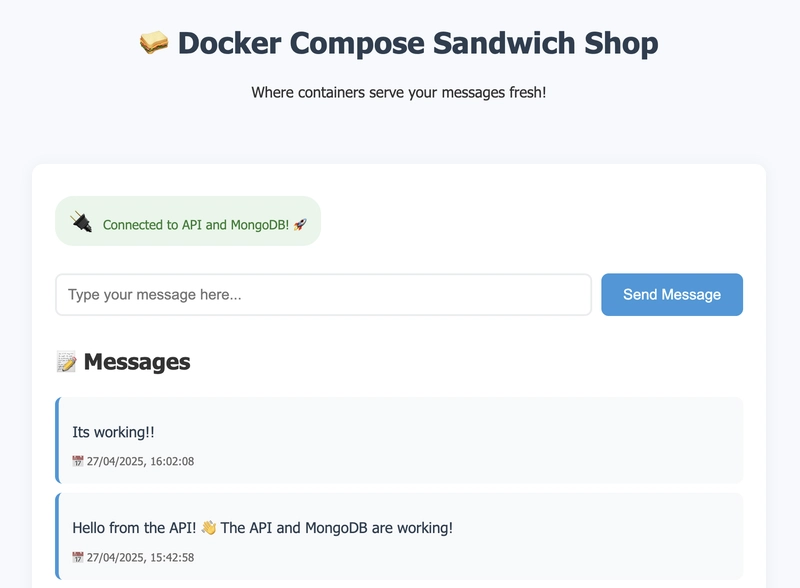Imagine you're making your favorite sandwich. You need:
- Bread and fillings
- Tools (knife, plate)
- A clean workspace
Now imagine if every time you wanted to make a sandwich, you had to:
- Set up your workspace and tools
- Prepare all ingredients
- Make and serve the sandwich
Sounds simple, right? What if you could write down these steps once, and just say "Make my sandwich" and everything happens automatically? That's exactly what Docker Compose does for your applications!
What is Docker Compose? 🥪
Docker Compose is like a recipe book that tells your computer how to set up all the parts of your application. Instead of a sandwich, think of a web application that needs:
- A web server (like your plate to serve)
- A database (like your ingredient shelf)
- Some storage (like your fridge)
The Magic Recipe (docker-compose.yml) 📝
version: '3'
services:
web:
image: nginx
ports:
- "80:80"
database:
image: postgres
environment:
- POSTGRES_PASSWORD=secret
This is like your sandwich recipe that says:
- Get your plate ready (web server)
- Organize your ingredients (database)
Why Use Docker Compose? 🤔
-
One Command Setup: Just say
docker-compose upand everything starts in the right order! - Always the Same: Like following a recipe, you get the same result every time
- Easy to Share: Share your recipe, and others can make the exact same setup
Prerequisites 🛠️
Before we start making our sandwich (I mean, running our app), let's make sure we have all the tools:
- Docker Desktop (Download)
- Docker Compose (Don't worry, it comes with Docker Desktop!)
You can check if everything's ready by running:
docker --version
docker-compose --version
Common Commands 🔪
docker-compose up # Start making
docker-compose down # Clean up
docker-compose ps # Check what's running
Best Practices 🌟
-
Keep It Simple
- Only add what you need
- Start small, grow as needed
-
Stay Organized
- Label everything clearly
- Keep related things together
Common Problems and Solutions 🔧
-
"My Containers Won't Talk!"
- Like ingredients that need to mix, containers need to connect
- Docker Compose handles this automatically
-
"My Data Disappeared!"
- Use volumes to save data:
volumes:
- ./my_data:/app/data
Real Example 🚀
Check out our demo app:
- A webpage to show messages
- An API to handle requests
- MongoDB to store everything
Visit http://localhost:8080 to try it out!
UI 🖥️
What's Next? 💭
We'd love to hear from you! Tell us:
- What topics would you like to learn more about?
- Which parts need more explanation?
- What real-world problems are you trying to solve?
Drop your comments below or open an issue in our GitHub repository!
Want to see this in action? Check out the companion repository with working examples!




Top comments (6)
😀再次Docker。再试一次。我可以。,我认为。,这比Docker更轻,但在阅读了你的文章之后。再一次。它比Docker更轻,但读完后,比Docker更轻。比Docker更多。所以我再次使用servbay,它比Docker更好。比我再次使用servbay好,因此,所以我再次使用servbay。我又用了一次。,butink Docker太复杂了。应该的Docker太漂浮了。Docker我一直想分享!感谢你的
Thanks for the kind words! 😊
Glad to hear the article helped clarify things.
Servbay is a great tool for lightweight setups, but Docker Compose shines when managing multiple services.
Happy coding!
honestly docker always confused me but breaking it down like this actually helps a lot - you think most tech folks actually remember all this stuff or just google it every time?
Haha, honestly, even experienced tech folks Google it when they need to! 😂
It's more about understanding the basics and knowing what to look for.
Happy to hear the article made things easier for you! 🚀 Keep going!
Some comments may only be visible to logged-in visitors. Sign in to view all comments.